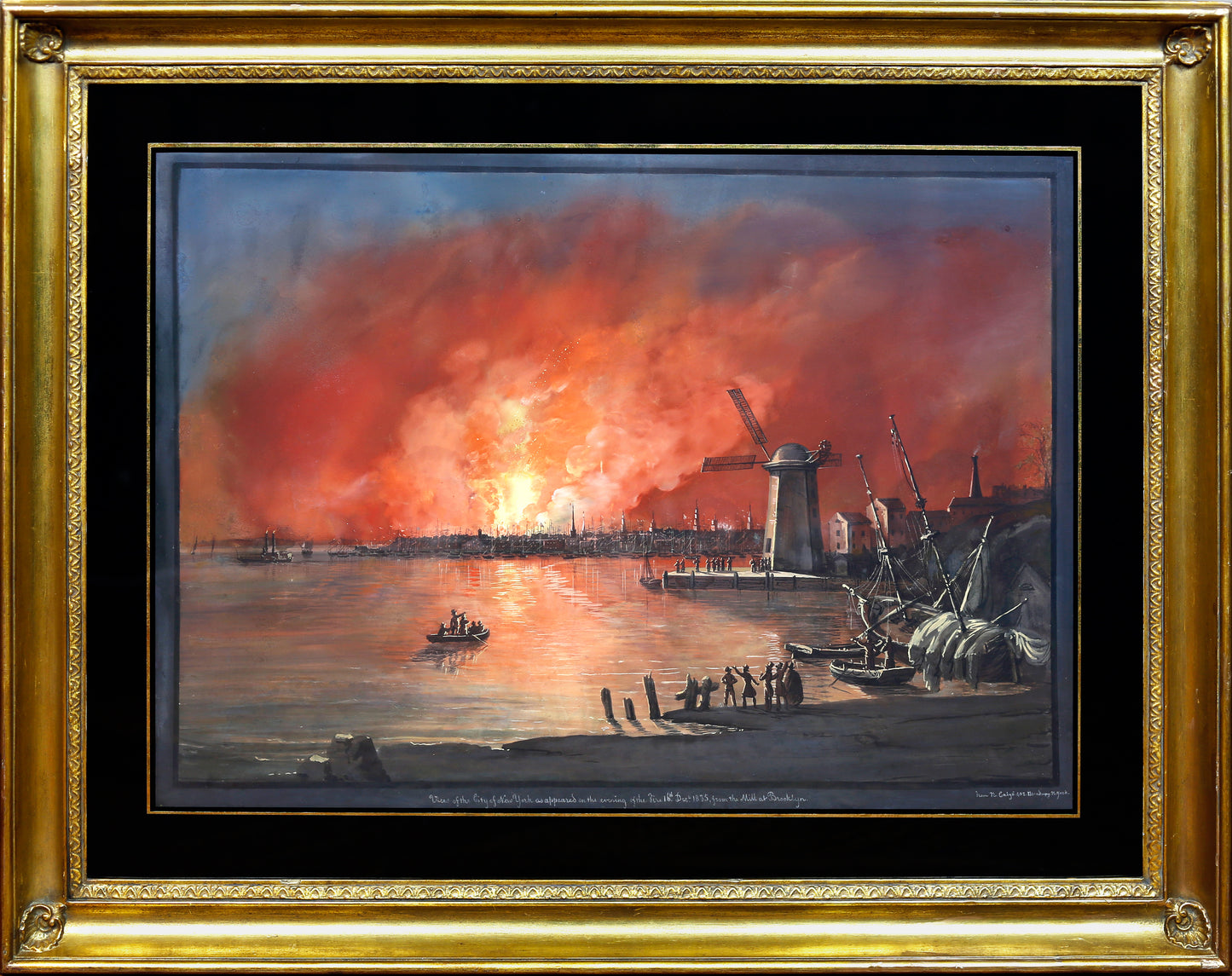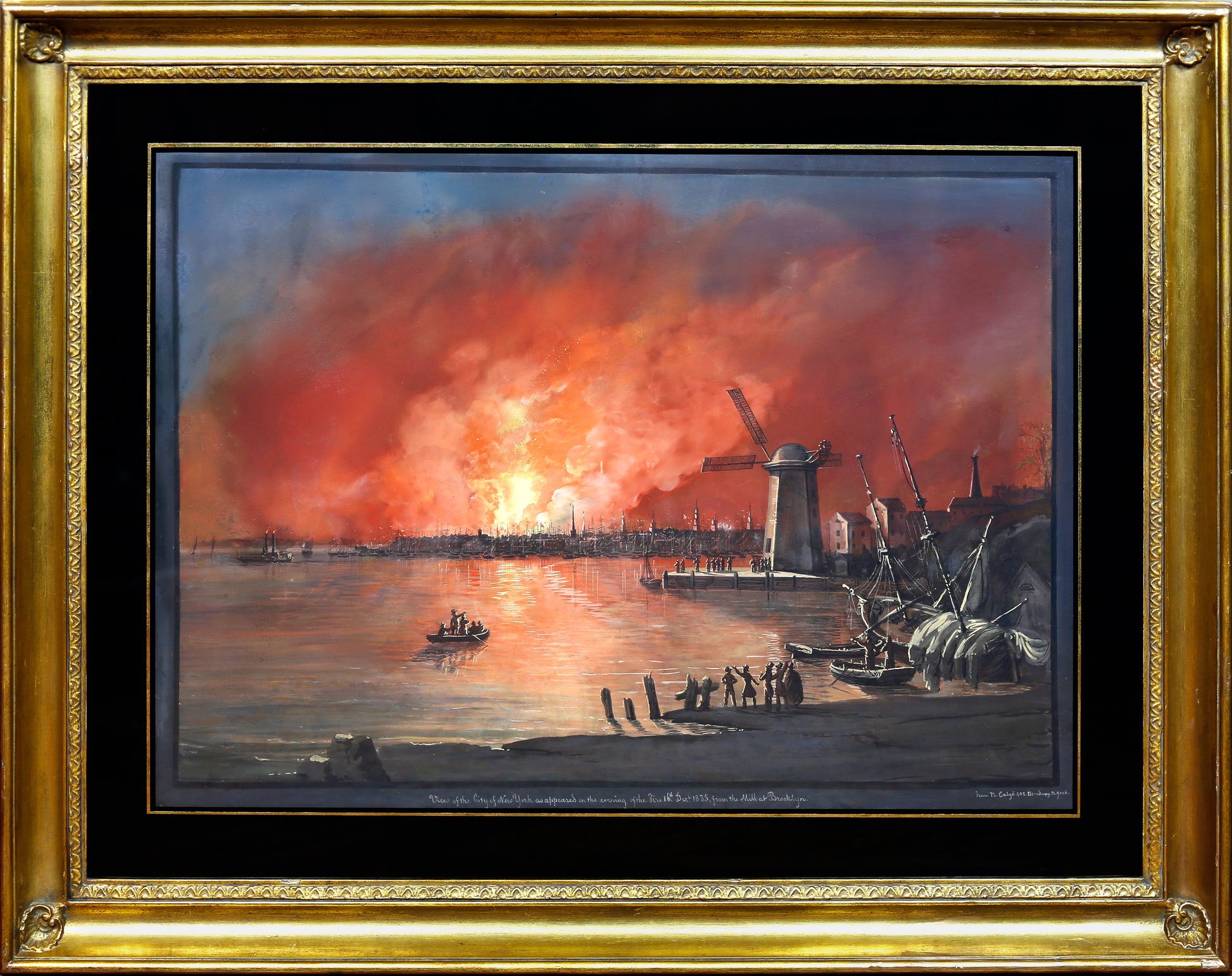from: U.S. City Views
NICOLINO CALYO (1799-1884). View of New York City as It Appeared on the Eve of the Fire, 1835.
NICOLINO CALYO (1799-1884). View of New York City as It Appeared on the Eve of the Fire, 1835.
Couldn't load pickup availability
NICOLINO CALYO (1799-1884)
View of New York City as It Appeared on the Eve of the Fire, 1835
Gouache on paper
Signed, dated, and inscribed at (I.r.): ‘View of the City of New York as it appeared on the evening of the fire 16th Dec 1835 from the mill at Brooklyn’; (at l.r.): ‘From N. Calyo. 402. Broadway N. York’
20” x 27 1⁄2” visible, 28 3⁄8” x 36 1⁄2” framed
On the eve of December 16, 1835, a warehouse at 25 Merchant Street (now Beaver Street) in Lower Manhattan, New York City burst into flames. The weather conditions were the primary cause for the devestating wreckage to ensue. Frigid temperatures had frozen many of the city’s water sources, severely hampering firefighters’ ability to control the flames. Strong winds spread the fire rapidly and engulfed wooden buildings in the densely packed commercial district. Ultimately more than 600 structures were destroyed and resulted in around $20 million in damages—a staggering sum at the time.
This historic event, known now as the Great Fire of 1835, was cemented in public memory in great part due to the Italian painter Nicolino Calyo. Born in Naples in 1799, Calyo studied at the Academy of Fine Arts in Naples. After participating in the 1820 rebellion against the Bourbon king of Naples, Ferdinand IV, he was forced to flee the territory, and briefly settled in Malta from 1829 to around 1832. He crossed the atlantic and eventually made his way to Baltimore by 1834. On June 16, 1835, the Baltimore Republican reported that Calyo was on his way north to Philadelphia and New York to paint views of those cities.
Calyo arrived in New York just in time to witness the great fire of December 1835, which destroyed much of the downtown business district. His large gouaches of the fire, reminiscent of Neapolitan views of the eruption of Mount Vesuvius, established Calyo’s reputation in the city. Two of his paintings were reproduced in aquatint by William James Bennett which led to the canonical status of Calyo’s depictions of the fire. Caylo’s remained deeply connected to the city that brought him fame and settled there for the rest of his life, with the exception of possible trips to Spain.
In addition to his depictions of the Great Fire, his oeuvre consists of views of American cities, harbors, and natural wonders, as well as a series of images of local street vendors entitled New York Street Cries, Chanters and Views (1840- 44). He also created a diorama of the Mexican War in 1847 and a panorama of the Connecticut River in 1848.
Calyo’s work can be found in the collections of The Metropolitan Museum of Art, New- York Historical Society, and the Museum of the City of New York; Baltimore Museum of Art and Maryland Historical Society, Baltimore; and the Amon Carter Museum, Fort Worth, Texas.
In his View of New York as It Appeared on the Eve of the Fire, 1835, Calyo rendered the blaze in Manhattan from the shoreline in Brooklyn. The sky is drenched a dramatic red as the fire licks the night sky. A handful of spectators crowd at the water’s edge and beneath the windmill at the right, watching the devastation.
One of at least 22 known depictions of the great fire completed by Calyo. Other examples found at the Metropolitan Museum of Art (54.90.174), Museum City of New York (60.119.8), MFA Houston (B.2013.3), New York Historical Society (1926.78) (1980.53) (1980.54)


